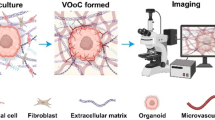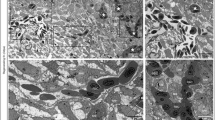Abstract
In vertebrates, supply of oxygen and nutrients to tissues is carried out by the blood vascular system through capillary networks. Capillary patterns are closely mimicked by endothelial cells cultured on Matrigel, a preparation of basement membrane proteins. On the Matrigel surface, single randomly dispersed endothelial cells self-organize into vascular networks. The network is characterized by a typical length scale, which is independent of the initial mean density of deposed cells \(\bar n\) over a wide range of values of \(\bar n\). We give here a detailed description of a mathematical model of the process which is able to reproduce several qualitative and quantitative features of in vitro vascularization experiments. Cell matter is basically modelled as an elastic fluid subjected to a specific force field depending on the concentration of a chemoattractant factor. Starting from sparse initial data, mimicking the initial conditions realized in laboratory experiments, numerical solutions reproduce characteristic network structures, similar to observed ones, whose average size is theoretically related to the finite range of chemoattractant diffusion. A possible area of application of the model is the design of properly vascularized artificial tissues.
Similar content being viewed by others
References
Ambrosi, D. and L. Preziosi (2002). On the closure of mass balance models for tumor growth. Math. Mod. Meth. Appl. Sci. 12, 737–754.
Burgers, J. (1974). The Non-Linear Diffusion Equation, D. Reidel Publ. Co.
Byrne, H. M., J. R. King, D. L. S. McElwain and L. Preziosi (2003). Appl. Math. Lett. 16, 567–573.
Carmeliet, P. (2000). Mechanisms of angiogenesis and arteriogenesis. Nat. Med. 6, 389–395.
Cleaver, O. and P. Krieg (1998). VEGF mediates angioblast migration during development of the dorsal aorta in Xenopus. Development 125, 3905–3914.
Di Talia, S., A. Gamba, F. Lamberti and G. Serini. Role of inhibiting factors in mascularization dynamics, in preparation.
Folkman, J. and C. Haudenschild (1980). Angiogenesis in vitro. Nature 288, 551–556.
Fong, G., L. Zhang, D. Bryce and J. Peng (1999). Increased hemangioblast commitment, not vascular disorganization, is the primary defect in flt-1 knockout mice. Development 126, 3015–3025.
Gamba, A., D. Ambrosi, A. Coniglio, A. de Candia, S. Di Talia, E. Giraudo, G. Serini, L. Preziosi and F. Bussolino (2003). Percolation, morphogenesis, and Burgers dynamics in blood vessels formation. Phys. Rev. Lett. 90, 118101.
Gazit, Y., D. A. Berk, M. Leunig, L. T. Baxter and R. K. Jain (1995). Scale-invariant behavior and vascular network formation in normal and tumor tissue. Phys. Rev. E 75, 2428–2431.
Gengrinovitch, S., B. Berman, G. David, L. Witte, G. Neufeld and D. Ron (1999). Glypican-1 is a VEGF165 binding proteoglycan that acts as an extracellular chaperone for VEGF165. J. Biol. Chem. 274, 10816–10822.
Grant, D., K. Tashiro, B. Segui-Real, Y. Yamada, G. Martin and H. Kleinman (1989). Two different laminin domains mediate the differentiation of human endothelial cells into capillary-like structures in vitro. Cell 58, 933–943.
Gurbatov, S., A. Malakhov and A. Saichev (1991). Non-Linear Random Waves and Turbulence in Nondispersive Media: Waves, Rays, Particles, Manchester: Manchester United Press.
Guyton, A. and J. Hall (2000). Textbook of Medical Physiology, St. Louis: W.B. Saunders.
Helmlinger, G., M. Endo, N. Ferrara, L. Hlatky and R. Jain (2000). Formation of endothelial cell networks. Nature 405, 139–141.
Hillen, T. and H. Othmer (2000). Chemotaxis equations from the parabolic limit of velocity jump processes. SIAM J. Appl. Math. 61, 751–775.
Holmes, M. and B. Sleeman (2000). A mathematical model of tumor angiogenesis incorporating cellular traction and viscoelastic effects. J. Theor. Biol. 202, 95–112.
Keller, E. F. and L. A. Segel (1970). Initiation of slime mold aggregation viewed as an instability. J. Theor. Biol. 26, 399–415.
Kubota, Y., H. Kleinman, G. Martin and T. Lawley (1988). Role of laminin and basement membrane in the morphological differentiation of human endothelial cells into capillary-like structures. J. Cell. Biol. 107, 1589–1598.
LeVeque, R. (1990). Numerical Methods for Conservation Laws, Zurich: Birkhauser.
Manoussaki, D., S. R. Lubkin, R. B. Vernon and J. D. Murray (1996). A mechanical model for the formation of vascular networks in vitro. Acta Biotheor. 44, 271–282.
Mardia, K. and P. Jupp (1999). Directional Statistics, John Wiley & Sons.
Muller, Y., H. Christinger, B. Keyt and A. de Vos (1997). The crystal structure of vascular endothelial growth factor (VEGF) refined to 1.93 Å resolution: multiple copy flexibility and receptor binding. Structure 5, 1325.
Murray, J. and G. Oster (1984). Cell traction models for generation of pattern and form in morphogenesis. J. Math. Biol. 19, 265–279.
Ngwa, G. and P. Maini (1995). Spatio-temporal patterns in a mechanical model for mesenchymal morphogenesis. J. Math. Biol. 33, 489–520.
Othmer, H. and T. Hillen (2002). Chemotaxis equations from the diffusion limit of transport equations. SIAM J. Appl. Math. 62, 1222–1250.
Othmer, H. and A. Stevens (1997). Aggregation, blowup and collapse: the ABC’s of generalized taxis. SIAM J. Appl. Math. 57, 1044–1081.
Pluen, A., P. A. Netti, R. K. Jain and D. A. Berk (1999). Diffusion of macromolecules in agarose gels: comparison of linear and globular configurations. Biophys. J. 77, 542–552.
Richardson, T., M. Peters, A. Ennett and D. Mooney (2001). Functional small-diameter neovessels created using endothelial progenitor cells expanded ex vivo. Nat. Biotech. 19, 1029–1034.
Ruhrberg, C., H. Gerhardt, M. Golding, R. Watson, S. Ioannidou, H. Fujisawa, C. Betsholtz and D. Shima (2002). Spatially restricted patterning cues provided by heparin-binding VEGF-A control blood vessel branching morphogenesis. Gen. Dev. 16, 2684–2698.
Serini, G., D. Ambrosi, E. Giraudo, A. Gamba, L. Preziosi and F. Bussolino (2003). Modeling the early stages of vascular network assembly. EMBO J. 22, 1771–1779.
Shandarin, S. and Y. Zeldovich (1989). The large-scale structure of the universe: turbulence, intermittency, structures in a self-gravitating medium. Rev. Mod. Phys. 61, 185–220.
Stauffer, D. and A. Aharony (1994). Introduction to Percolation Theory, London: Taylor & Francis.
Vasiev, B. and C. J. Weijer (1999). Modelling chemotactic cell sorting during Dictyostelium discoideum mound formation. Biophys. J. 76, 595–605.
Velázquez, J. J. L. (2002). Stability of some mechanisms of chemotactic aggregation. SIAM J. Appl. Math. 5, 1581–1633.
Vergassola, M., B. Dubrulle, U. Frisch and A. Noullez (1994). Burgers’ equation, devil’s staircases and the mass distribution for large-scale structures. Astron. Astrophys. 289, 325–356.
Vernon, R., J. Angello, M.-L. Iruela-Arispe, T. Lane and E.-H. Sage (1992). Reorganization of basement membrane matrices by cellular traction promotes the formation of cellular networks in vitro. Lab. Invest. 66, 536–546.
Walter, M., W. Cook, S. Ealick, T. Nagabhushan, P. Trotta and C. Bugg (1992). Three-dimensional structure of recombinant human granulocyte-macrophage colony-stimulating factor. J. Mol. Biol. 224, 1075.
Author information
Authors and Affiliations
Corresponding author
Additional information
An erratum to this article is available at http://dx.doi.org/10.1016/j.bulm.2005.01.001.
Rights and permissions
About this article
Cite this article
Ambrosi, D., Gamba, A. & Serini, G. Cell directional and chemotaxis in vascular morphogenesis. Bull. Math. Biol. 66, 1851–1873 (2004). https://doi.org/10.1016/j.bulm.2004.04.004
Received:
Accepted:
Issue Date:
DOI: https://doi.org/10.1016/j.bulm.2004.04.004




